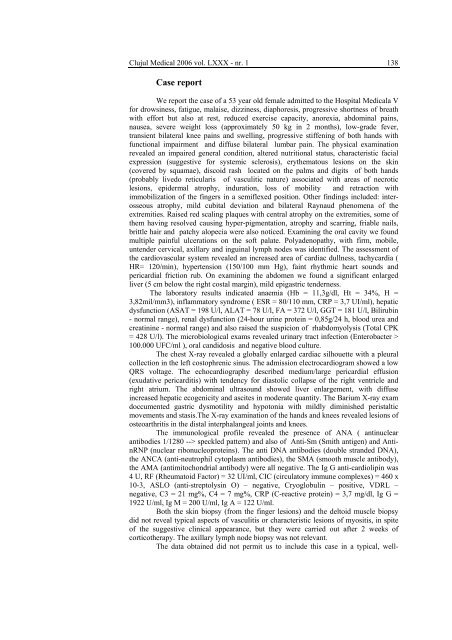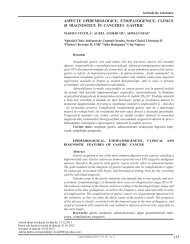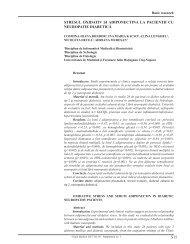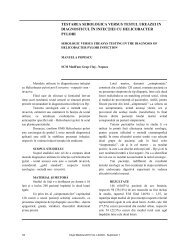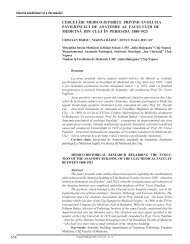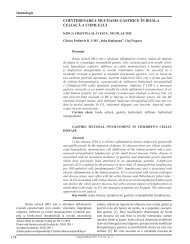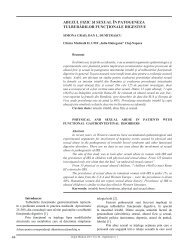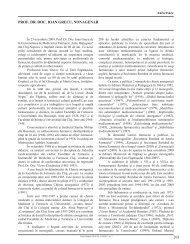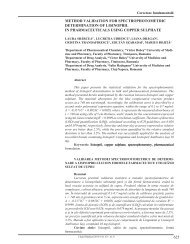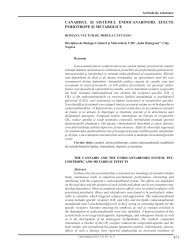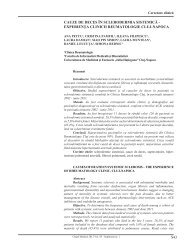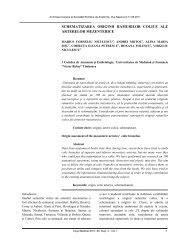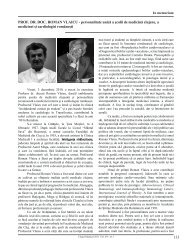You also want an ePaper? Increase the reach of your titles
YUMPU automatically turns print PDFs into web optimized ePapers that Google loves.
<strong>Clujul</strong> <strong>Medical</strong> 2006 vol. LXXX - nr. 1<br />
Case report<br />
We report the case of a 53 year old female admitted to the Hospital <strong>Medical</strong>a V<br />
for drowsiness, fatigue, malaise, dizziness, diaphoresis, progressive shortness of breath<br />
with effort but also at rest, reduced exercise capacity, anorexia, abdominal pains,<br />
nausea, severe weight loss (approximately 50 kg in 2 months), low-grade fever,<br />
transient bilateral knee pains and swelling, progressive stiffening of both hands with<br />
functional impairment and diffuse bilateral lumbar pain. The physical examination<br />
revealed an impaired general condition, altered nutritional status, characteristic facial<br />
expression (suggestive for systemic sclerosis), erythematous lesions on the skin<br />
(covered by squamae), discoid rash located on the palms and digits of both hands<br />
(probably livedo reticularis of vasculitic nature) associated with areas of necrotic<br />
lesions, epidermal atrophy, induration, loss of mobility and retraction with<br />
immobilization of the fingers in a semiflexed position. Other findings included: interosseous<br />
atrophy, mild cubital deviation and bilateral Raynaud phenomena of the<br />
extremities. Raised red scaling plaques with central atrophy on the extremities, some of<br />
them having resolved causing hyper-pigmentation, atrophy and scarring, friable nails,<br />
brittle hair and patchy alopecia were also noticed. Examining the oral cavity we found<br />
multiple painful ulcerations on the soft palate. Polyadenopathy, with firm, mobile,<br />
untender cervical, axillary and inguinal lymph nodes was identified. The assessment of<br />
the cardiovascular system revealed an increased area of cardiac dullness, tachycardia (<br />
HR= 120/min), hypertension (150/100 mm Hg), faint rhythmic heart sounds and<br />
pericardial friction rub. On examining the abdomen we found a significant enlarged<br />
liver (5 cm below the right costal margin), mild epigastric tenderness.<br />
The laboratory results indicated anaemia (Hb = 11,3g/dl, Ht = 34%, H =<br />
3,82mil/mm3), inflammatory syndrome ( ESR = 80/110 mm, CRP = 3,7 UI/ml), hepatic<br />
dysfunction (ASAT = 198 U/l, ALAT = 78 U/l, FA = 372 U/l, GGT = 181 U/l, Bilirubin<br />
- normal range), renal dysfunction (24-hour urine protein = 0,85g/24 h, blood urea and<br />
creatinine - normal range) and also raised the suspicion of rhabdomyolysis (Total CPK<br />
= 428 U/l). The microbiological exams revealed urinary tract infection (Enterobacter ><br />
100.000 UFC/ml ), oral candidosis and negative blood culture.<br />
The chest X-ray revealed a globally enlarged cardiac silhouette with a pleural<br />
collection in the left costophrenic sinus. The admission electrocardiogram showed a low<br />
QRS voltage. The echocardiography described medium/large pericardial effusion<br />
(exudative pericarditis) with tendency for diastolic collapse of the right ventricle and<br />
right atrium. The abdominal ultrasound showed liver enlargement, with diffuse<br />
increased hepatic ecogenicity and ascites in moderate quantity. The Barium X-ray exam<br />
doccumented gastric dysmotility and hypotonia with mildly diminished peristaltic<br />
movements and stasis.The X-ray examination of the hands and knees revealed lesions of<br />
osteoarthritis in the distal interphalangeal joints and knees.<br />
The immunological profile revealed the presence of ANA ( antinuclear<br />
antibodies 1/1280 --> speckled pattern) and also of Anti-Sm (Smith antigen) and AntinRNP<br />
(nuclear ribonucleoproteins). The anti DNA antibodies (double stranded DNA),<br />
the ANCA (anti-neutrophil cytoplasm antibodies), the SMA (smooth muscle antibody),<br />
the AMA (antimitochondrial antibody) were all negative. The Ig G anti-cardiolipin was<br />
4 U, RF (Rheumatoid Factor) = 32 UI/ml, CIC (circulatory immune complexes) = 460 x<br />
10-3, ASLO (anti-streptolysin O) – negative, Cryoglobulin – positive, VDRL –<br />
negative, C3 = 21 mg%, C4 = 7 mg%, CRP (C-reactive protein) = 3,7 mg/dl, Ig G =<br />
1922 U/ml, Ig M = 200 U/ml, Ig A = 122 U/ml.<br />
Both the skin biopsy (from the finger lesions) and the deltoid muscle biopsy<br />
did not reveal typical aspects of vasculitis or characteristic lesions of myositis, in spite<br />
of the suggestive clinical appearance, but they were carried out after 2 weeks of<br />
corticotherapy. The axillary lymph node biopsy was not relevant.<br />
The data obtained did not permit us to include this case in a typical, well-<br />
138


